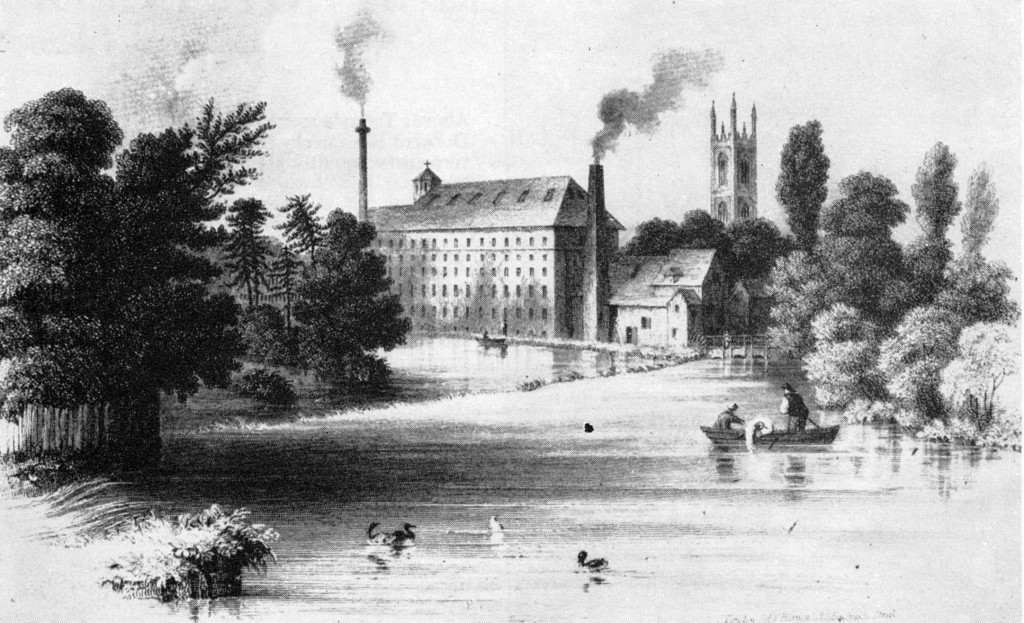Key Figures – Thomas, John & Henry Lombe

Key Figures – Thomas, John and Henry Lombe
The Lombe family play a key role in the story of the Derwent Valley Mills World Heritage Site, for their work to establish a Silk Mill at Derby, unlike any previous undertaking in England. Stephanie Hitchcock has researched their background history.
The Lombes are a long established Norfolk family. The ‘Derby Silk Mill’ line originated from Cawston, Norfolk – they were owners of a farm adjacent to which they had built a substantial tannery office. This property was left to the eldest son Edward Lombe, who died on February 4th 1703. His granddaughter Elizabeth Warner married Paul Jodrell, Solicitor General to the Prince of Wales and Lord of the Manor of Belper, Derbyshire.
The second son Thomas was apprenticed to a master weaver in Norwich. Here he established a successful weaving business, purchasing a considerable estate in St Georges, Colgate, where he died leaving his wife Elizabeth, four sons Thomas, William, John and Henry and two daughters Elizabeth and Margaret.
Thomas, the eldest son, was only 19 when he inherited the worsted weaving business, in which he also prospered, increasing the wealth of the family. Thomas never married and retired, passing on the Weaving/Merchant business to his younger brother Henry.
Henry Lombe was born in 1659, married Margaret, a widow, with whom he had two sons: Thomas, born September 5th 1685 and Henry born September 21st 1686. Both sons were baptized on June 25th 1704 at the Octagon Presbyterian Chapel, Norwich. By his second wife Willmott he had Benjamin, alive when Henry made his will but who died in childhood, and John born in 1693. Henry made his will on August 28th 1693, proved in 1695 by John Hall. The sons of his first marriage were left in the charge of Henry’s executors John Hall, worsted weaver and his brother-in-law and Anthony Alexander, a tanner and his friend. Supervisors of the will were his brothers Thomas and William. The executors were instructed “to bring up the two older sons Thomas and Henry and put them both apprentices to such honest trades and employment as my sons shall choose”. The two younger sons were left to be cared for and educated by Willmott his wife.
It was these three surviving sons – Thomas, Henry and John – who were involved in the Derby Silk Mill, the first true factory ever built. The life of Thomas is well documented. He was apprenticed to a London Mercer, Samuel Totton and in 1707, aged 22, he was admitted to the Mercers’ Company and made a Freeman of the City of London. He became an Alderman for Brassishaw Ward in the City of London, becoming sheriff and giving a congratulatory address to George II on his accession to the throne in 1727. By tradition, he was knighted. He married Elizabeth Turner, daughter of John and Hannah Turner of Kent. They had two daughters, Hannah born 1725 who in June 1740 married Sir Robert Clifton, baronet and Mary Turner, born 1732 who married April 1749 James Maitland, the 7th Earl of Lauderdale.
John, his half brother, is more difficult to trace as very few original documents have been discovered to date. However a number of factors must have contributed to John and Thomas Lombe exploring the potential for silk to be processed in their own country. These were: an extensive knowledge of worsted weaving; the custom for merchants to send their sons to various countries to obtain training; family links with Europe; and the need to free English Manufacturers from the importation of expensive Italian Organzine.
Whatever the truth they commenced the construction of the Derby Silk Mill about 1715 on an island in the River Derwent at Derby, partly financed by their Uncle William Lombe and near to the unsuccessful silk mill of Thomas Crotchet. Their knowledge of Derby and this mill may have been obtained via their Uncle John Hall, Sheriff and later Mayor of Norwich who in the 1690s was involved with George Sorocold who laid water pipes in Tombland, Norwich.
Thomas Lombe obtained a standard 14 year patent (422) in 1718 for ‘A new invention of three sorts of engines never before made or used in Great Britaine, one to winde the finest raw silk, another to spin, and the other to twist the finest Italian raw silk into organzine in great perfection, which was never before done in this country.
John Lombe managed the Silk Mill. His will is dated May 20th 1720 and like many of his ancestors died at an early age on November 20th 1722. He was buried on November 22nd at All Saints, Derby, leaving the bulk of his estate to his half brother and partner Thomas. Having expended a considerable sum on the building of the Mill only seven years previously his death must have caused great anxiety to Thomas, not only for financial reasons but over who would manage this concern. Also on John’s death Uncle William Lombe declined any further financial involvement in the business.
From a wonderfully descriptive letter written by Henry Lombe of Norwich (brother of Thomas and half brother of John) dated Derby January 4th 1723 to his brother-in-law Benjamine Willis, (Norfolk RO MC 257/59/20) we learn that Thomas Lombe was in Derby until December 24th 1722 and from December 7th had been instructing Henry “with every part of the business”. This proved to be only a short term solution as to who would be manager because Henry Lombe shot himself and was buried on June 19th 1723 at the church of St. Michaels Derby.
The House of Commons adopted a resolution on February 14th 1732 for extension of the patent. On March 9th 1732 four petitions were presented from Manchester, Macclesfield, Leek and Stockport against such an extension. On March 10th 1732 the Mayor, Aldermen etc of Derby stated that “Sir Thomas Lombe’s invention was detrimental to the woollen manufacturers and borough in general. Although the engine employed great numbers, the erection thereof had materially increased the Poor Rates; extension of the patent would only continue the grievance”. The second reading was on March 14th 1732, then it was sent to Committee. His Majesty commanded him (Chancellor of Exchequer) to recommend to them to make recompense to Sir Thomas. The House in Obedience to the King’s message made a grant of £14,000 on March 20th 1732, one of the conditions being that models of his machinery were to be put on display in a public institution.
Sir Thomas Lombe died on January 3rd 1739 leaving an estimated fortune of £120,000 in equal parts to his wife and two daughters. William Hutton, writing later in the 18th century suggests that Lombe forgot to inform that he had already accumulated more than £80,000. By this statement Hutton assumes that the £120,000 fortune had been made solely from the silk business, failing to understand or investigate the Lombes and their background.
Text written by and copyright Stephanie Hitchcock

